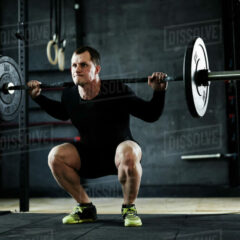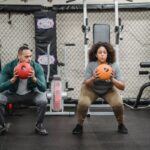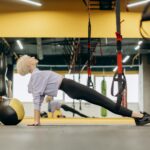https://weightliftingforpower.com/power-through-top-arm-workout-mistakes-to-avoid/
Top Arm Workout Mistakes To Avoid
Arm workouts often take center stage for those looking to improve their strength and aesthetics. Strong, well-defined arms don’t just turn heads; they are crucial in daily tasks and athletic performance. Whether you’re lifting groceries or swinging a tennis racket, the power generated by arm muscles is essential.


To fully tap into the potential of arm workouts, it’s essential to have a basic understanding of arm anatomy. The biceps, triceps, and forearms form the trifecta of muscles you’ll want to focus on. Biceps are often associated with the classic ‘flex,’ while triceps, making up about two-thirds of the arm’s mass, help in pushing movements. Forearms, sometimes overlooked, are vital for grip strength and overall arm function.
An often underestimated aspect of any workout is the mind-muscle connection. Paying attention to the form maximizes the exercises’ effectiveness and reduces the risk of injuries. Concentrating on each movement ensures you’re engaging the right muscles and not just going through the motions.
By understanding these basics and focusing on maintaining good form, you’re setting the stage for effective arm workouts that yield tangible results. It is a foundation supporting growth, strength, and daily functional effectiveness.
Mistake #1: Overdependence on Isolation Movements
Many folks zero in on isolation exercises like bicep curls, thinking they’re the ultimate solution for arm growth. While these can target specific muscles, relying solely on them might make you miss out on the more significant benefits of compound movements.
Compound exercises such as push-ups, pull-ups, and bench presses simultaneously engage multiple muscle groups. This holistic approach enhances strength and boosts muscle coordination and balance. It’s like getting more bang for your buck because you’re working out more muscles in a single move.
Integrating a balanced mix of isolation and compound exercises in your routine is key. Think of your workout plan as a well-rounded playlist where each track—or exercise—contributes to the overall vibe, ensuring you don’t ignore any muscle group.
Allocating time strategically for these exercises is essential. While it’s tempting to spend an entire session curling dumbbells, incorporating exercises like dips or even weighted chin-ups can create a dynamic and efficient workout. Mastering the balance of these elements will transform your workouts, making them more enjoyable and significantly more effective.
Mistake #2: Ignoring Form for Higher Weights
Chasing heavier weights can be tempting, especially when you want quick gains. But here’s the deal: lifting more isn’t always the answer. When form takes a backseat, injuries might sneak up unexpectedly, sidelining your progress altogether.
It’s easy to get caught up in the numbers, thinking that heavier weights always mean better results. However, those big numbers might be vanity without the correct form. Proper form ensures that each rep is as effective as possible, engaging the intended muscles fully and preventing unnecessary strain on joints.
Personal trainers or well-reviewed instructional videos can provide valuable insights into nailing the correct posture and movement for different exercises. It’s not just about bending and lifting; it’s about engaging the right muscles each time.
Pay close attention to your movement patterns next time you’re at the gym. Focus on the technique first, then worry about the weight. For common arm exercises, ensure your elbows are stable during bicep curls and that your arms form a right angle at the elbow during tricep extensions. These minor tweaks can significantly maximize your workout efficiency and effectiveness.
Mistake #3: Inadequate Recovery and Nutrition
Pushing your body to its limits during workouts is one side of the equation, but the real gains come in the downtime. Skipping proper recovery can slow your progress and lead to burnout. To achieve maximum strength and growth, allowing your muscles sufficient recovery time following the stress of exercise is crucial. Taking this time enhances your performance, prevents injury, and promotes overall health.

Recovery isn’t just about resting, though. It’s about bright rest. Giving your arms 48 hours of rest before hitting the same muscles again can significantly improve performance. Techniques like active recovery, including light stretching or low-impact activities, help maintain flexibility and circulation without over-exerting the muscles.
Nutrition plays a massive role in recovery. Think of food as fuel. Post-workout nutrition, including proteins and carbohydrates, aids in muscle repair and replenishes glycogen stores. Timing matters, too. Consuming a balanced meal within two hours of exercising can optimize recovery.
Integrating practices like hydration and sleep is crucial in a recovery plan. Drinking enough water keeps muscles hydrated and functioning properly. Adequate sleep supports the body’s natural growth processes and repair, leaving you feeling refreshed and ready for the next session.
Adopting a holistic approach, balancing intense workouts with adequate rest, nutrition, and hydration, ensures that arm workout efforts are both sustainable and effective.
https://www.wealthyaffiliate.com?a_aid=352a86b2
https://weightliftingforpower.com/equipment-free-core-power-
https://weightliftingforpower.com/how-core-power-influences-mental-health/
https://weightliftingforpower.com/nutrition-and-core-power/
https://weightliftingforpower.com/core-power-in-injury-prevention/
https://weightliftingforpower.com/the-science-behind-core-power/









 Let’s get straight: core strength and power are not identical twins. Strength is about how much force your muscles can exert. Grasping this distinction is vital for comprehending how movement and energy interact and influence each other. Imagine lifting a heavy box versus tossing a basketball; strength helps lift, while power enables that swift throw.
Let’s get straight: core strength and power are not identical twins. Strength is about how much force your muscles can exert. Grasping this distinction is vital for comprehending how movement and energy interact and influence each other. Imagine lifting a heavy box versus tossing a basketball; strength helps lift, while power enables that swift throw.




 Setting realistic goals is half the battle when it comes to core training. Identifying what you want to achieve is essential, whether it’s enhanced stability, strength, or even visual aesthetics. This clarity can guide your exercise choices and keep you motivated.
Setting realistic goals is half the battle when it comes to core training. Identifying what you want to achieve is essential, whether it’s enhanced stability, strength, or even visual aesthetics. This clarity can guide your exercise choices and keep you motivated.


